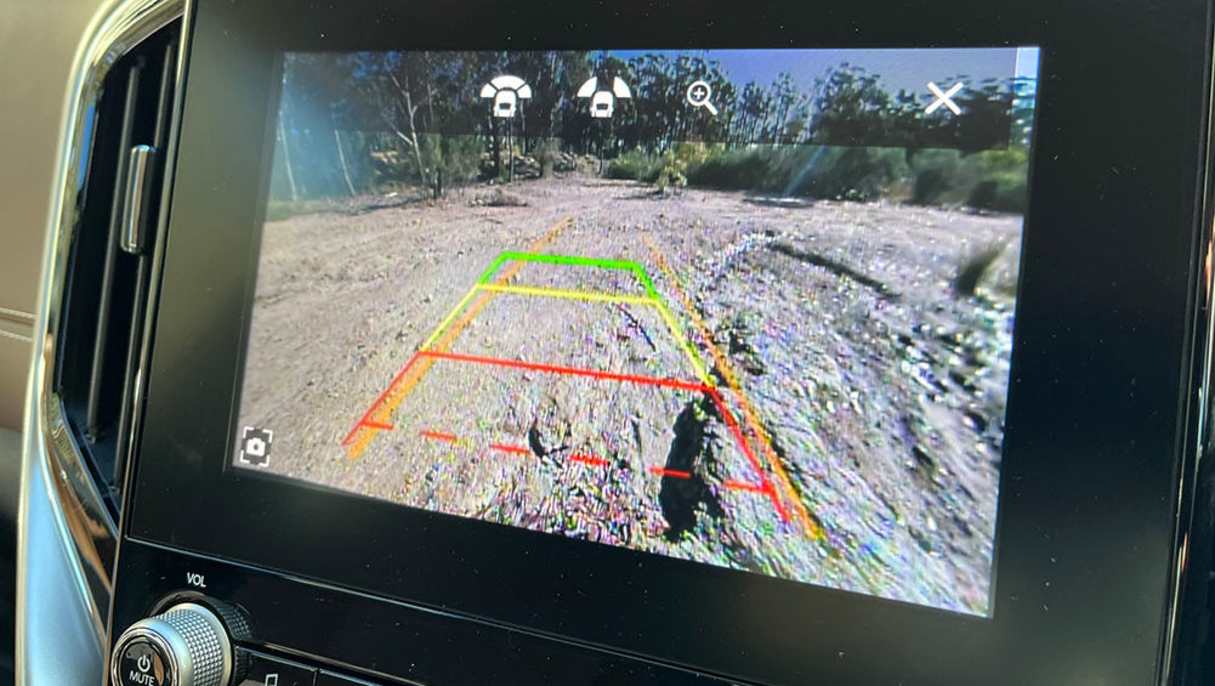The driver-assist tech in a lot of new vehicles has the potential to be intrusive and annoying – from traffic sign recognition that’s woefully incorrect, to adaptive/active cruise control that is preemptive and too abrupt, through to stop-start functions that should be taken out the back and disposed of.
And that’s during general everyday driving duties.
But spare a thought for those who venture off-road because there’s a raft of driver-assist tech that’s aimed at making a vehicle’s performance on challenging terrain safer and smoother – a noble goal indeed – but at times some of this tech goes awfully astray in its execution.
Off-road traction control, hill-descent control, track cameras and transparent bonnet functions are almost de rigueur in off-road vehicles nowadays but that doesn't mean the tech is without its flaws.
I’ll preface this yarn by saying: none of the tech or issues listed below are deal-breakers and they are likely being addressed as you read this or are planned to be addressed or have already been addressed by way of recalibration, software updates or the like…
Read on.
Off-road traction control
Safe controlled momentum from a reliable foundation of traction are crucial to safe 4WDing.
That’s why when off-road traction control systems are flawed, unreliable or deliver otherwise patchy efficacy, your off-road fun-time is under threat.
Sure, big units such as the Ford F-150 Lariat long-wheelbase are weighty cumbersome beasts and not really at home in low-range 4WDing, but while the F truck’s four-wheel drive mechanicals – low-range gearing, engine braking etc – are all as sound as a pound, baby, its traction control system is ye olde clunky. When the terrain becomes challenging, the off-road traction control system seems to whirr and click and clunk away, rather than deliver any meaningful effectiveness, in terms of limiting useless wheel-spin in open air and sending torque to the wheels with at least some traction. It's not a smooth, reliable system.

Same goes for GWM offerings. But while the Tank 500 Hybrid Lux’s intrusive and over-reactive driver-assist tech was the source of much frustration on the road, the Cannon Alpha Lux’s off-road driver-assist tech, namely its traction control system, was the worst offender out of all of these driver-assist tech niggles.
This off-road traction control is preemptive and too intrusive: it does work, but it kicks in when it really shouldn’t: either activating in an abrupt, ill-timed fashion or robbing the ute of precious momentum by backing off or cutting out. The system needs to be better calibrated and more precise in its activation.
Even something as fun as the Suzuki Jimny XL suffers from off-road traction control quirks. When low-range 4WDing in the Jimny, you have to use plenty of throttle – keeping the revs up and the wheels spinning in order to get the most out of that traction control system – and that can create problems.
The system uses sensors to detect and analyse driving conditions and anticipate vehicle motion, to optimise power distribution to the wheels and prevent loss of grip before it happens – great, in theory; less so in reality.

Because it's so small and light, the Jimny can be severely unsettled by severe changes in terrain or driving conditions – a surprise wheel drop into a deep rut, or a sudden shift in onboard load, or a wind gust while driving up a rocky hill. These abrupt forced shifts in weight or wheel placement can become tricky, even serious, issues to overcome if the Jimny tips in one direction too suddenly. Add in an off-road traction control that may work in fits and bursts and an unpredictable situation may become even worse.
The Toyota RAV4 Hybrid Cruiser’s AWD system / traction control is supposed to transfer power from the slipping wheels to the gripping wheels but in the past it’s not worked as well as it should have - for me, anyway - on mildly challenging terrain.
Trail mode acts like an automatic limited slip differential – applying brake force to the free-rotating wheel and sending the torque to the wheel with traction. It’s supposed to brake the wheel that has no traction and send torque to the wheel with traction, in order to keep you moving.
On the driver display it showed power going to the rear, but the wheels in the air continued to spin freely.
Hill-descent control
When hill-descent control works well, it’s a great addition to a vehicle’s suite of driver-assist tech. Case in point: the Ford Everest’s hill descent control is smooth and effective, holding very low speeds (sometimes registering as 0km/h on the dash), and is not jerky or jarring like some systems can be. Speed can be adjusted via buttons on the steering wheel.
Hill-descent control is aimed at keeping an off-roader to a low and controlled speed while that vehicle drives down the hill.

The Jeep Grand Cherokee Overland has an okay off-road traction control system, but it’s let down by off-road driver-assist aids, which are slow to engage (eg. when switching between drive modes). A clunky hill-descent control system, on one of my tests, didn’t hold to a low speed at all, instead seeming to free-wheel down steeper slopes once momentum kicked in – and that’s far from ideal.
The GWM Cannon-X’s traction control is on the wrong side of ordinary, not active enough, and it disengages (on the front axle) when the rear diff is locked, but hill-descent control comes in for extra criticism: it’s patchy and doesn’t maintain a fixed low speed on steep downhill slopes as seamlessly as most other utes.
Track cameras / 360-degree view cameras / digital rear-view mirrors
The idea behind the track camera (aka 360-degree view camera, aka surround-view camera) is admirable. As well as providing improved driver vision during everyday driving in the city and suburbs, these camera systems have the potential to greatly enhance driver vision on bush tracks.
Great in theory, less so in real life.
For example, even though the 2024 Mahindra Scorpio Z8L forward-facing camera comes in handy. I still think of these as more a novelty – I prefer to get out and check the track ahead or get a spotter to do the work for me. The image is distorted though and if you’re wholly reliant on these then schedule time for a headache. However, I can see the inherent value of this tech in helping the driver to maintain vision, especially if forward visibility is compromised, say for instance up and over the crest of a steep rocky hill, or edging towards a steep drop into a creek bed.

Further to that point, I still think driver-assist tech that has off-road applications – such as the track-view/360-degree camera and vehicle-info read-out (displaying driveline/diff lock indicators, and steering, pitch and roll angles etc) in the Ford Ranger Tremor – are more novelty than necessity, but I have become more used to them – if not enamoured with them – as time goes on.
Plenty of off-roaders also tow (camper-trailers, caravans, boats, horse floats etc) and the introduction of tech such as digital rear-view mirrors has no doubt added another level of safety to those who tow.
The digital rear-view mirror in the Chevrolet Silverado HD LTZ Premium certainly comes in handy when you’re towing because you’re able to essentially erase the towed item from view if your trailer has a camera – but with general use it’s a headache-inducing novelty due to its slightly blurry, off-kilter fish-eye view of the world at the rear.

Transparent bonnet / transparent chassis
Being able to see the track immediately in front of your vehicle is a definite advantage.
Visibility in the GWM Tank 500 Hybrid Lux is impacted in places due to the style of the cabin build, but the Tank’s transparent chassis function aims to address that issue, at least somewhat.

This system is similar to the Land Rover Defender’s 'transparent bonnet' view in that its aim is to extend the range of the around-view camera to include a view under the vehicle (represented on-screen as a ‘ghost vehicle’ outline when Transparent Chassis is selected).
But I'd rather stick my head out the window and have a look at the track or stop the vehicle, get out and have a good look at the track ahead.
These transparent functions are of some value, but you shouldn’t rely on them – nothing beats your own real-time, real-world view of the track.

Parking sensors
In the past, these beeping mongrels could be switched off but that process, especially in vehicles that are a few years old, is sometimes a painfully laborious one, requiring the driver to cycle through menus and sub-menus to reach the actual function – and that task has to be done all over again when the vehicle is restarted.

Thankfully, car manufacturers have cottoned on to just how annoying these sensor alarms can be and have, in recent vehicle generations, made the process of switching them off much easier – now it’s a simple press of a button.
Ah, sweet progress.





.jpg)

.jpg)
.jpg)

.jpg)


.jpg)


.jpg)
.jpg)


.jpg)
.jpg)
.jpg)
.jpg)
 (1).jpg)



